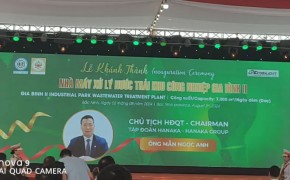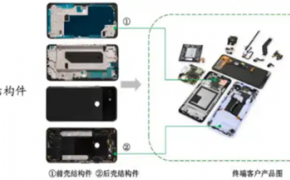永道射频旗下的永道越南分公司董事长何毅达在越南兴安省的总体规划公告上发表讲话,宣布永道将在越南北部的兴安省投资6700万美元(约合人民币4.86亿),越南兴安省2021-2030年总体规划和促进投资的会议上,永道越南获得了该项目的投资注册证书。

永道射频技术股份有限公司,归属于永丰余“科技事业群”版块,于2007年8月正式营运,是全球一流的RFID标签制造商。主要产品包含RFID天线设计与制造、电子标签封装、读写器设计与制造、应用系统整合等。截止2022年底RFID标签销售量累计超185亿个,2021年底年产能达50亿个(扬州厂、台北厂年产能分别为40亿、10亿枚)。
永道射频公司目前是全球最大的RFID工厂,中国扬州的江苏永道射频技术股份有限公司于2014年开始运营,是国内较早进入RFID领域的企业之一。永道为不同客户提供个性化的RFID电子标签,产品广泛应用于零售、公共生活、工业制造、交通物流等领域,最终客户涵盖优衣库、迪卡侬、国家电网、洋河、富士通等国内外知名企业。
2022年后永道继续对扬州工厂进行了升级改造。永道公布的2024年第一季度财务报告显示,合并营收达到了9.01亿新台币,同比增长53.4%。毛利率从去年同期的32.02%提升至35.73%,增加了3.5个百分点。永道一季度净利润也实现了惊人的87%的增长。同时4月份营收也翻倍增长,达到了3.92亿新台币,月增17.5%,年增111.2%。
这一增长不仅得益于RFID技术在全球范围内的持续普及和应用,也得益于永道在产能提升和全球化布局方面的不断努力。同时也预示着RFID技术在新零售、物流等领域的应用将持续扩大,为永道等RFID厂商带来更多的市场机遇。
去年,永道成功完成了台湾厂房的扩建、美国子公司的设立以及越南新厂的选址与申设。此次投资去年选址申设的越南工厂获批后,建成的产能预计将是扬州工厂的两倍,达到每年300亿个的RFID产品,相当于2023年的全球需求。相关数据显示,2023年全球的RFID产品出货量不到260亿。
永道认为随着疫情改变了消费者的购物习惯,以及疫情后的劳动力短缺和劳动成本上升等因素,物流产业正在积极寻找更为高效的运营模式。在这个过程中,RFID标签被视为一种卓越的解决方案,而永道也在积极地准备和提供相应的解决方案,以满足物流行业的需求。
另外,随着物联网、人工智能等技术的不断发展,RFID技术将在更多领域得到广泛应用,为永道等RFID厂商带来更多的发展机遇。同时,永道也将积极把握新兴应用市场的机遇,推动RFID标签在更多领域的广泛应用,为全球客户提供更加优质的产品和服务。
越南永道工厂是扬州的2倍,并且远超当下全球市场需求,永道是不是要放弃扬州工厂的产能,目前还有待观察。
不过有行业数据公司预测,到2028年,全球RFID标签芯片出货量预计将超过1100亿,相当于现在RFID产品的4倍以上,这也证明行业迫切需要一个强大的供应链。
而在全球供应链正在重组的背景下,越南吸引外商直接投资(FDI)在新投资资金和新增投资资金方面仍在增高,表明外国投资者继续将越南视为中长期的重要投资目的地。
外商直接投资(FDI)流量强劲增长是2024年上半年越南国内生产总值(GDP)增速达到6.42%的重要动力。半导体、电子、能源等领域的许多新签、增资大型FDI项目纷纷落地。这也是计划与投资部向政府提出2024年更高的经济增长目标(7%)的重要底气。
目前越南外商直接投资资金主要集中在拥有良好的基础设施、稳定的人力资源、行政体制改革效果显著的省市,诸如北宁、巴地头顿、广宁、河内、海防、胡志明市、同奈等省市,投资者主要为来自新加坡、中国、日本、中国香港、韩国等越南在亚洲的传统伙伴。
2024年6月10日,政府总理签发第489号决定(489/QĐ-TTg),批准《2021-2030年兴安省规划和2050年愿景》(以下简称《兴安省规划》)。《兴安省规划》确定了到2030年的总体目标,即兴安省快速可持续发展,成为具有经济规模和发展水平位居全国前列的现代化工业省份。
其中,兴安省地区生产总值(GRDP)年均增长率为9.0%;到2030年人均GRDP将达到2.78亿越南盾(折合人民币约为8万元)。2030年全省经济结构:农业和渔业3.6%;工业和建筑业64.1%;服务业占25.4%。2021-2030年期间社会投资总额约为700万亿越南盾(折合人民币约为2千亿元)。到2030年,兴安省货物出口额将达到约120-130亿美元,2021-2030年期间年均增长率为8.5%-9.0%。
2050年愿景,兴安发展成为中央直辖市;成为智慧,富裕、美丽、文明的城市;充分发挥当年的庯宪(PhốHiến)文化的核心价值;是红河三角洲值得居住的地方;拥有同步的现代化基础设施系统;是本地区各地方与全国的联系中心。
He Yida, Chairman of Coopers Radio Frequency Viet Nam Branch, delivered a speech at the announcement of the master plan of Hung Yen Province, Viet Nam, announcing that Coopers will invest 67 million US dollars (about RMB 486 million) in Hung Yen Province in northern Viet Nam, and at the meeting of the 2021-2030 master plan and investment promotion in Hung Yen Province, Viet Nam, Viet Nam, obtained the investment registration certificate for the project.

Coopers Radio Frequency Technology Co., Ltd., which belongs to the "Technology Business Group" section of Yongfengyu, was officially put into operation in August 2007 and is the world's first-class RFID tag manufacturer. The main products include RFID antenna design and manufacturing, electronic tag packaging, reader design and manufacturing, application system integration, etc. By the end of 2022, the cumulative sales volume of RFID tags exceeded 18.5 billion, and the annual production capacity reached 5 billion by the end of 2021 (the annual production capacity of Yangzhou plant and Taipei plant was 4 billion and 1 billion pieces, respectively).
Coopers RF is currently the world's largest RFID factory, and Jiangsu Coopers RF Technology Co., Ltd. in Yangzhou, China, started operation in 2014 and is one of the earliest enterprises in China to enter the RFID field. Coopers provides personalized RFID electronic tags for different customers, and its products are widely used in retail, public life, industrial manufacturing, transportation and logistics and other fields, and the final customers include Uniqlo, Decathlon, State Grid, Yanghe, Fujitsu and other well-known enterprises at home and abroad.
After 2022, Coopers continued to upgrade the Yangzhou factory. According to the financial report for the first quarter of 2024 released by Coopers, the consolidated revenue reached NT$901 million, a year-on-year increase of 53.4%. Gross profit margin increased by 3.5 percentage points to 35.73% from 32.02% in the same period last year. Coopers also achieved an astonishing 87% increase in net profit in the first quarter. At the same time, revenue also doubled in April to NT$392 million, up 17.5% month-on-month and 111.2% year-on-year.
This growth is not only due to the continuous popularization and application of RFID technology around the world, but also due to the continuous efforts of Coopers in capacity improvement and global layout. At the same time, it also indicates that the application of RFID technology in new retail, logistics and other fields will continue to expand, bringing more market opportunities to RFID manufacturers such as Coopers.
Last year, Coopers successfully completed the expansion of the Taiwan plant, the establishment of a subsidiary in the United States, and the site selection and application for a new plant in Viet Nam. After the approval of the Viet Nam factory last year, the completed production capacity is expected to double that of the Yangzhou plant, reaching 30 billion RFID products per year, equivalent to global demand in 2023. Relevant data show that in 2023, the global shipment of RFID products will be less than 26 billion.
Coopers believes that as the pandemic has changed consumers' shopping habits, as well as factors such as labor shortages and rising labor costs after the pandemic, the logistics industry is actively looking for more efficient operating models. In this process, RFID tags are seen as an excellent solution, and Coopers is actively preparing and providing corresponding solutions to meet the needs of the logistics industry.
In addition, with the continuous development of technologies such as the Internet of Things and artificial intelligence, RFID technology will be widely used in more fields, bringing more development opportunities to RFID manufacturers such as Coopers. At the same time, Coopers will also actively grasp the opportunities of emerging application markets, promote the wide application of RFID tags in more fields, and provide better products and services for global customers.
The Viet Nam factory is twice the size of Yangzhou and far exceeds the current global market demand, and it remains to be seen whether Coopers will abandon the capacity of the Yangzhou factory.
However, some industry data companies predict that by 2028, global RFID tag chip shipments are expected to exceed 110 billion, equivalent to more than 4 times that of current RFID products, which also proves that the industry urgently needs a strong supply chain.
Against the backdrop of the ongoing restructuring of the global supply chain, Viet Nam's attraction of foreign direct investment (FDI) is still increasing in terms of new investment funds and new investment funds, indicating that foreign investors continue to regard Viet Nam as an important investment destination in the medium to long term.
Strong growth in foreign direct investment (FDI) flows is an important driver for Viet Nam's gross domestic product (GDP) growth rate to reach 6.42% in the first half of 2024. Many large-scale FDI projects in the fields of semiconductors, electronics, and energy have been launched. This is also an important reason for the Ministry of Planning and Investment to propose to the government a higher economic growth target of 7% in 2024.
At present, Viet Nam's FDI funds are mainly concentrated in provinces and cities with good infrastructure, stable human resources, and remarkable results in administrative system reform, such as Bac Ninh, Ba Ria Vung Tau, Quang Ninh, Hanoi, Hai Phong, Ho Chi Minh City, Dong Nai and other provinces and cities, and the investors are mainly Viet Nam's traditional partners in Asia from Singapore, China, Japan, Hong Kong, Korea, etc.
On June 10, 2024, the Prime Minister issued Decision No. 489 (489/QĐ-TTg) approving the Hung Yen Provincial Plan 2021-2030 and Vision 2050 (hereinafter referred to as the "Hung Yen Provincial Plan"). The "Hung Yen Provincial Plan" sets the overall goal of 2030, that is, Hung Yen Province will develop rapidly and sustainably, and become a modern industrial province with economic scale and development level that ranks among the top in the country.
Among them, the average annual growth rate of Hung Yen province's gross domestic product (GRDP) is 9.0%; By 2030, the per capita GRDP will reach 278 million Viet Nam (equivalent to about 80,000 yuan). The economic structure of the province in 2030: agriculture and fishery 3.6%; industry and construction 64.1%; Services accounted for 25.4 per cent. The total amount of social investment in the period 2021-2030 is about 700 trillion Viet Nam (equivalent to about 200 billion yuan). By 2030, the value of goods exports from Hung Yen province will reach about 12 billion to 13 billion US dollars, with an average annual growth rate of 8.5%-9.0% during the period 2021-2030.
Vision 2050, Hung Yen will develop into a municipality directly under the central government; To become a smart, wealthy, beautiful and civilized city; Give full play to the core values of the PhốHiến culture of that year; It is a great place to live in the Red River Delta; Synchronized modern infrastructure systems; It is the focal point between the regions of the region and the whole country.








